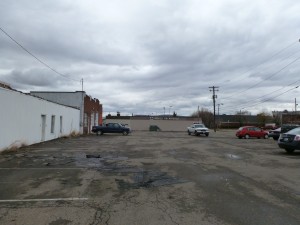
repentantly Downtown Elmira.
http://offsecnewbie.com/2020/12/31/vulnhub-brokengallery-live/?relatedposts=1 I wrote on this blog about a trip of mine to Hannibal, Missouri, the adorable little river-town where Mark Twain spent his boyhood. In our imaginations the writer is so associated with the Mississippi River that I believe it it something of a crime that he is not buried along its course. It is of course acceptable for a young man to go off and seek success in the big city; but the true heroic journey is always circular, and there is something wrong, even insulting, to know that the poet of the Mississippi spent most of his life far away from it, in East-Coast corridors of comfort and privilege, and he died and was buried in Elmira, New York, at the time a respectable bourgeois manufacturing center in New York’s Southern Tier.
And so when I happened to be spending a day passing through the region I knew where I would be stopping. I would close the circle and pay my respects to the tomb of the man born Samuel Clemens of Missouri.
A map of New York tells you little of what you will find on the ground: two cities that appear equal on the map may be entirely different, as I found years ago when I was charmed by Rochester and depressed by Syracuse; elated by the loveliness of Brockport and made pensive by the bleakness of Woodbourne. An old regional center can be elegant and promising like Kingston – or it can be broken-down and terminal like Elmira.
Elmira seems to have suffered the fate of many other nice towns, in that it maintained its importance into the 20th century: and so the wrecking-ball of progress destroyed what the automation of labor and the centrifugal sprawl of car culture could not. The old Main Street is lined with new buildings, graceless, boxy, cheap, where no one could live – there were no residences in them – and no one would want to do business (they also lacked shopfronts). Every single building I saw there built before World War II seemed worth keeping, and every one built after worth destroying. But the downtown area had probably been fifty percent remade since the war, which meant in practice that it had been fifty percent destroyed. One of the first places I saw was a one-story building from the 1960s or 70s which had been condemned by the city as “unfit for human habitation.” The only saving grace of that architectural era is that it did not build for the ages.
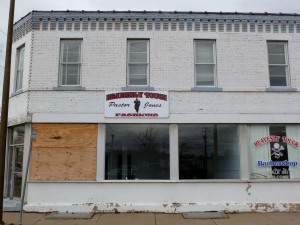 As often happens in such towns parking was abundant – in fact there were almost no cars – but all metered. Not knowing how long my pilgrimage to the Twain sites would take, and not willing to risk a ticket – the meters would take two hours’ worth of my money and no more – I parked at the far edge of downtown, in front of an old brick-Romanesque church with a German inscription in terra cotta: ERSTE DEUTSCHE EVANGELISCHE KIRCHE. I passed along a pair of blighted blocks, what once were buildings or yards turned into empty parking lots. One building had been the plaything of some churchman’s business ambitions: “Heavenly Touch Pastor Jones Fashions” and “Heavenly Touch Barber Shop.” “A cut above the rest,” it said. Both businesses had long since closed. On a Thursday afternoon I could not see another human being in any direction.
As often happens in such towns parking was abundant – in fact there were almost no cars – but all metered. Not knowing how long my pilgrimage to the Twain sites would take, and not willing to risk a ticket – the meters would take two hours’ worth of my money and no more – I parked at the far edge of downtown, in front of an old brick-Romanesque church with a German inscription in terra cotta: ERSTE DEUTSCHE EVANGELISCHE KIRCHE. I passed along a pair of blighted blocks, what once were buildings or yards turned into empty parking lots. One building had been the plaything of some churchman’s business ambitions: “Heavenly Touch Pastor Jones Fashions” and “Heavenly Touch Barber Shop.” “A cut above the rest,” it said. Both businesses had long since closed. On a Thursday afternoon I could not see another human being in any direction.
Elmira had been large enough to have multiple important streets – an entire grid as opposed to a single street or crossing of streets – and so the government buildings are scattered throughout the downtown. They are still functioning: county court, county offices, an impressive beaux-arts city hall, and a vast immaculate federal court. Along with the churches – which were multiple, massive, and impressive, though with a desolate air – the government seemed to be the only thing left in Elmira. There was something almost medieval about the persistence of church and state while the third estate dwindled away to insignificance.
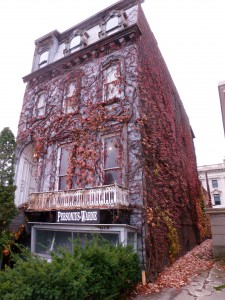 I found an odd business still left, the photography studios of Personius-Warne, which boasted they they had been in place since 1893, in a brownstone in the center of town. It was now the only brownstone left, all the others having been bulldozed. In 1893 they had made glorious crisp silver prints of ladies in hoop skirts and men in seersucker; people like the Clemens family; now they did mostly high school portraits.
I found an odd business still left, the photography studios of Personius-Warne, which boasted they they had been in place since 1893, in a brownstone in the center of town. It was now the only brownstone left, all the others having been bulldozed. In 1893 they had made glorious crisp silver prints of ladies in hoop skirts and men in seersucker; people like the Clemens family; now they did mostly high school portraits.
I turned north on Main Street, whose brownstone and brick had been replaced with au-courant commercial spaces, Rite-Aid and Walgreen’s and McDonald’s, with their familiar idiotic architectural graceless sameness. There were two Twain sites on my map: the “Mark Twain Study,” near Elmira College on the north end of town; and a few miles past that, his gravesite.
The appearance of the college was somewhat surprising to me: it had not been heralded by coffee shops, pizzerias, a bookshop, or any of the usual accoutrements of college-town living. Past the grimy gas station and equally grimy Chinese restaurant were a few houses and then suddenly the college, where fresh-faced undergraduates walked around, half of them dressed more neatly and respectably, and half dressed more slovenly and disreputably, than anyone else in town. Most of them were staring into their hands, presumably at iPhones.
The Twain study was, to my surprise, on the campus of the college. It was an enclosed octagonal gazebo, not more than twelve feet in diameter but quite spacious nonetheless, with glass windows on seven sides and a stone fireplace on the eighth. It had been built in 1874 at Twain’s request, and like many things of its era it conveyed in equal parts sturdiness and comfort. It was open only on weekends, but it was small and to peer through the window was to visit it. Here Twain wrote Tom Sawyer, and “other novels,” as the sign indicated. It was a fine space for a writer, small and cozy but big enough to converse or pace in. Its furnishings were simple: a few chairs, a table, a poker and ash-shovel and tongs, a guestbook, and a few mementoes of the author: a portrait, a few pictures, and a small marble statue, presumably of Joan of Arc (of whom Twain wrote a biography).
It had been moved to its current location – Americans have had a fair fetish for moving buildings with sentimental associations. The house where Lee surrendered to Grant at Appomattox was dismantled for a trip to the Columbian Exposition in Chicago and spent a few decades in boxes before the National Parks Department laboriously reconstructed it; the Poe House and Hamilton Grange in New York were moved to make way for progress; and most spectacularly, London Bridge was purchased and moved to Lake Havasu City in Arizona. The Twain Study was built on Quarry Farm, the family home of Twain’s first wife, Olivia Langdon. The farm, some miles outside of town, was given to Elmira College decades ago, and now is a residence for writers and not generally open to the public; but some sage decided that the actual place where Twain had done his writing should be taken from the property and moved to a college campus, where it may look out not on pastoral quietude but an intermittent parade of nineteen-year-olds sending text messages.
Having taken a few photos and sat on the steps musing for awhile I set out for the graveyard. I had only the vaguest idea where it was. After walking more than a mile down what I thought was the right road I had some doubts; I could see the sidewalk disappear a few yards further. I spied a group of teenagers on tiny bicycles on a side street, and I yelled to them, asking if there was a graveyard down the road; they answered that it was not far off. A little more walking brought me to it soon enough as they had affirmed, and while most of the graves seemed recent, I did not doubt it was the right place. It was large and parklike, the way a late nineteenth century graveyard should be. There was no easy point of access, so I hopped over the wrought-iron fence in a place where it was relatively low. This was wise, as the fence got higher and the front gate turned out to be locked. I saw another teenager, this one passing through the cemetery, his face blank and his soul withdrawn into his headphones. I asked him if he knew where the grave of Mark Twain was. He took off his headphones and looked at me quizzically.
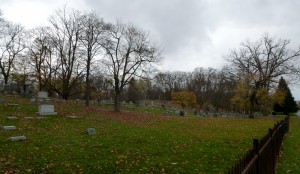 “I said do you know where the grave of Mark Twain is?”
“I said do you know where the grave of Mark Twain is?”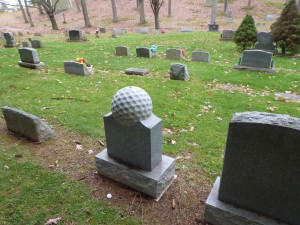
His face knotted with uncertain recognition. “Hmm…” he turned around and looked at the hill of graves behind him. “… I think it’s somewhere over there.” His arm was waving to a large hill that overlooked the road – a logical place for the fancy graves to be anyway. It seemed likely enough. I thanked him and headed uphill, while he tucked the buds into his ears again.
At the top of the hill I found the obelisks and angels which indicated I was in high-class grave territory, and in a relatively artistic age. Down below I had passed a grave that had a stone golfball carved onto its top, which seemed to me, like people, equal parts ridiculously entertaining and sadly superficial. Up on top of the hill, however, I found an intriguing statue of an inspired poet, pen in hand looking into the distance – in fact right at Twain’s grave – with the inscription:
I heard
a voice from heaven
saying unto me
Write
from henceforth
blessed are the
dead who die in
the Lord.
Twain’s grave was not far away, and a small sign directed me in no uncertain terms.
His plot is a family plot, in a grove of fine white oaks, where a pillar indicates that there are laid the remains of the Langdons, his first wife’s family. Twain is there, along with his two wives, three daughters, a granddaughter, and a son-in-law, Ossip Gabrilowitsch, who apparently attempted to be an artist himself. While Twain’s grave says merely:
SAMUEL LANGHORNE CLEMENS
– MARK TWAIN –
NOV.30,1835 – APR.21,1910
Gabrilowitsch, whose stone is identical, merits further the lapidary comment, awkwardly distributed over the stone:
OSSIP GABRILOWITSCH
REFLECTED IN HIS ART AND IN
HIS LIFE THE NOBLE BEAUTY OF
HIS LOFTY IDEALS
A nearby stele features bronze medallions of both Twain and Gabrilowitsch. The latter man may have been known in his day, but compared with the fame of Twain he seems like the very Bibulus of the dead: Bibulus, the unhappy consular colleague of Julius Caesar, was such a nonentity that even while he was in office people referred to his administration with Caesar as “the consulship of Julius and Caesar.”
The stones of Twain’s wife and children are indicative of the man’s inner sentimentality which was forever the sad root of his embittered humor.
IN THIS GRAVE REPOSE THE ASHES OF
OLIVIA LANGDON CLEMENS
THE BELOVED AND LAMENTED WIFE OF
SAMUEL L. CLEMENS
WHO REVERENTLY RAISES THIS STONE
TO HER MEMORY
ELMIRA,NOV.27,1845
FLORENCE,ITALY,JUNE 5,1904
“GOTT SEI DIR GNAEDIG, O MEINE WONNE.”
“God be gracious to thee, o my joy.”
OLIVIA SUSAN CLEMENS
MAR.19,1872 – AUG.18,1896
WARM SUMMER SUN SHINE KINDLY HERE,
WARM SUMMER WIND BLOW SOFTLY HERE,
GREEN SOD ABOVE
LIE LIGHT, LIE LIGHT –
GOOD NIGHT, DEAR HEART,
GOOD NIGHT, GOOD NIGHT.
– ROBERT RICHARDSON
IN MEMORY OF
JEAN LAMPTON CLEMENS
A MOST DEAR DAUGHTER
HER DESOLATE FATHER
SETS THIS STONE.
“AFTER LIFE’S FITFUL FEVER
SHE SLEEPS WELL.”
JULY 26,1880 – DEC.24,1909
Twain might have used any of these inscriptions in his famed works, but only in mockery.
I placed a native thistle on his grave, which I brought from Wildcat Mountain; it was as near I could come to his nature in a tribute: thorny, weedy, homespun, but beautiful in its own way and (in the species I chose) rare.
At the gravesite I found a letter placed under a rock, which I took the liberty of reading; it was addressed to Twain, written by a local artist who was attempting to fulfill Twain’s (tongue-in-cheek) plan of dedicating a statue to Adam, as the founder of pretty much everything human. Twain noted that with all the Darwinism running around people were likely to forget the importance of Adam to human history. The artist is correct, in that Twain’s idea, like so much of his humor, has remained relevant to American life to this day. Unfortunately the proper place for such a statue is probably not Elmira but Missouri, where it legitimately could become a rallying-point for the Christian-American rage against its own animal nature. And Joseph Smith tells us that Missouri is the site of the Garden of Eden, which would make a statue there all the more appropriate. And I may presume that Adam’s grave, due to technological limitations of the time, must be within walking distance of the garden itself.
The artist attempting to get the statue built clearly shared Twain’s humor, as he closed his letter (asking for assistance for a foundering project) by imploring him, “Don’t just lay there – do something.”
The only other tribute at Twain’s grave were coins – a penny and a nickel on his, a dime on his wife’s, and on his daughter’s stone a quarter – which I must confess I did not understand. Where they have gone, there is no ferryman to take fares. But I took them as a sad emblem of the thing which had brought Twain, as perhaps it brought Adam and his descendants, to forsake his hometown and forsake it forever. Twain was out for success – and he found it, but like so many others before him somehow it turned out to be more ashen-tasting to his palate than he could ever have imagined. As an artist he recognized that even though he was writing in Elmira everything he could ever possibly effectively write about was elsewhere. For Twain’s body to rest in Elmira is testament to the meaninglessness of success, which Twain all too keenly felt but could never come to grips with. There was no other ideal to live by. Living by it you are brought to places that have no inner meaning – that make no sense.
Hemingway said of Twain that all American literature comes from Huckleberry Finn, a statement I cannot second. (My favorite American writers, Irving and Thoreau, preceded it, as do Melville and Whitman. In fact I would say that Huckleberry Finn is more contained in Walden than vice versa). But an American literary tradition definitely does come from Twain, of the writer from the provinces heading to the coasts to court success, and writing with an eye by turns loving and exploitative of the people he grew up with. Crucial to these writers is their sense that they are better than their cradles – which gives them tremendous energy to set out seeking their treasure and no place to go once they have acquired it. Brooklyn is full of these people, and the problem is still the same.
Standing there staring at the gray granite monuments, I thought of Washington Irving, the greatly underrated American writer whose writings Twain must have known well – and on which he must have had some unkind opinion or other. Irving had maintained his capacity for loyalty and earnestness to the end, despite success and sorrow. He lived, as so many intelligent Americans must, abroad for years, but he returned to the river he loved, built a house to his own specifications, and bought a grave-plot in Sleepy Hollow, in the very graveyard which he made haunted with his Headless Horseman. Even while he was living in England he knew that this is the proper circular course of the pride of success, which in the end must acknowledge its sorry and pitiful and human and humble beginnings. Irving had made a pilgrimage to Stratford-on-Avon, where Shakespeare is buried, the famed malediction on his grave having prevented his remains being transferred to Westminster Abbey. Irving may justly be accused of having limitations as a writer, but the close of his essay on Stratford was utterly beyond the range of a much more naturally gifted wordsmith like Twain.
As I crossed the bridge on my return, I paused to contemplate the distant church in which the poet lies buried, and could not but exult in the malediction, which has kept his ashes undisturbed in its quiet and hallowed vaults. What honor could his name have derived from being mingled in dusty companionship with the epitaphs and escutcheons and venal eulogiums of a titled multitude? What would a crowded corner in Westminster Abbey have been, compared with this reverend pile, which seems to stand in beautiful loneliness as his sole mausoleum! The solicitude about the grave may be but the offspring of an overwrought sensibility; but human nature is made up of foibles and prejudices; and its best and tenderest affections are mingled with these factitious feelings. He who has sought renown about the world, and has reaped a full harvest of worldly favor, will find, after all, that there is no love, no admiration, no applause, so sweet to the soul as that which springs up in his native place. It is there that he seeks to be gathered in peace and honor among his kindred and his early friends. And when the weary heart and failing head begin to warn him that the evening of life is drawing on, he turns as fondly as does the infant to the mother’s arms, to sink to sleep in the bosom of the scene of his childhood.
How would it have cheered the spirit of the youthful bard, when, wandering forth in disgrace upon a doubtful world, he cast back a heavy look upon his paternal home; could he have foreseen that, before many years, he should return to it covered in renown; that his name should become the boast and glory of his native place; that his ashes should be religiously guarded as its most precious treasure; and that its lessening spire, on which his eyes were fixed in tearful contemplation, should one day become the beacon, towering amidst the gentle landscape, to guide the literary pilgrim of every nation to his tomb.
That kind of veneration Hannibal had for Twain; I had seen it with my own eyes, and seen how Twain’s ghost had made Hannibal a fine town – now nicer than Elmira, and a stopping-place for literary pilgrims indeed. But Twain had pursued other goals – and admittedly, in this country hometown loyalty is not one of the easier virtues. Even if you return to your hometown you may find that it has been utterly remade in your absence – the old buildings on Main Street torn down, and your more talented friends gone to seek their fortunes elsewhere. And so having seen what there was to see in the graveyard I picked my solitary way down through the graves, back over the wrought-iron fence, along the road that had no sidewalk, and back into the ugly remains of Elmira, where I got into my truck and continued on my westward way.
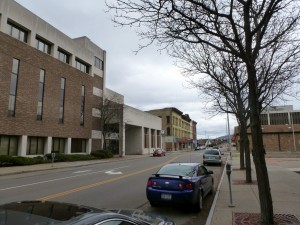
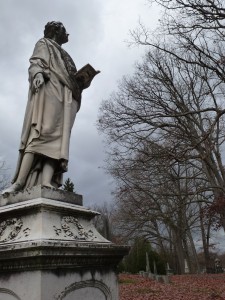
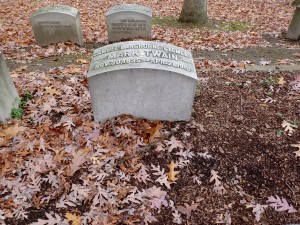
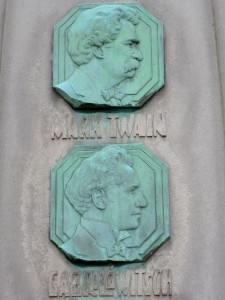
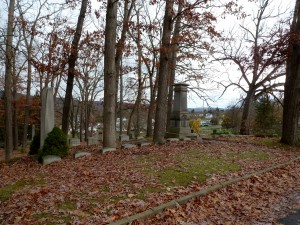
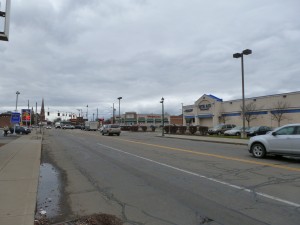
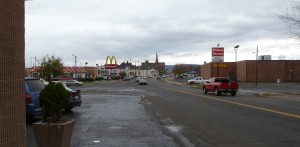
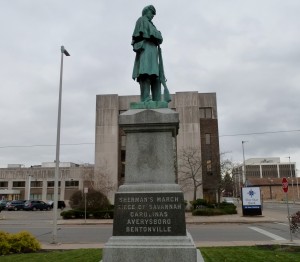
Post a Comment